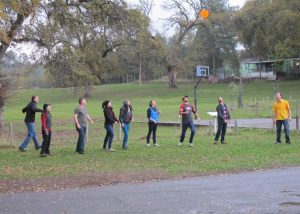 Now that you know to face the wind and to jam in a line, the next step is learning about lanes in the jam. This is a natural extension to the two previous skills. You might already be using this concept without knowing it. Basically you can think of a lane like a swimmer has a lane in a race. In the jam, the lane moves into the wind.
Now that you know to face the wind and to jam in a line, the next step is learning about lanes in the jam. This is a natural extension to the two previous skills. You might already be using this concept without knowing it. Basically you can think of a lane like a swimmer has a lane in a race. In the jam, the lane moves into the wind.
Each player moving in the line has their own lane going into the wind. As the disc moves between the players, each is responsible only for his or her own lane. So if the disc is in my lane, you do not move in front of me to get it. Rather, you wait for me to set it into your lane, either on purpose of by accident, and then you take over. In the same way, I will never go into your lane. If I lose control and the disc flies into your lane, I won’t step in front of you, even if you are not ready.
Why? This way we don’t crash into each other. This gives us each the opportunity to shine without encroaching on each others space. This keeps us safe. This let’s us know when we should go for it or when we should hold back. We all play better when we respect our lanes. And soon, a whole new level of magic forms because we can read each other’s movement.
I can not tell you how many times someone has jumped in front of me and “poached” a disc that was in my lane. It is very intimidating when someone who is out of control (or even in control) runs at you at full speed trying to save the disc. If you lose it, let it go. The person it goes to will save it and be a star. And when they lose it, you will be the star. Just hang out nearby and wait for your chance.
I’ve also seen newer players be afraid to step up into their lane. Don’t be afraid..that is unless you know the person next to you doesn’t respect the lane. Then look out! But if you’re next to me in the jam, be ready. Stay on my hip, in your lane. I will set it to you and I will expect you to crush a gitis! Nothing is more sad then when a perfect set comes your way and you don’t go for it. If you are properly situated in the line, in your lane, and the disc comes to you, it’s yours. Go get it. This is what lanes are all about.
So how do you know where your lane is? How wide is it? Does it go in a straight line? As a general rule, your lane is as wide as your reach to save and control the disc. So imagine your arm span. Can you brush or catch the disc from fingertip to fingertip? Hint: I can. If you can’t yet, keep working.

The wind is coming from the camera position.
The direction of the lane is formed by the wind and the jam line. The most basic jam line forms perpendicular to the wind direction. The lanes move directly into the wind. Here there is a small subtlety, based on the tilt of the disc. Since a disc spinning clock will tend to tilt out of the wind to the right, the lanes bend slightly to the right of the wind direction. Also, the people on the left of the disc can be slightly upwind while the people on the right can be slightly downwind. Of course, counter is a mirror image: the lanes bend left and the people on the right can move slightly upwind.
However, this is all based on the current tilt of the disc. If the disc is directly in the wind, your lane goes into the wind. As the disc tilts, so does the lane. And as you become better at predicting how and when the disc will tilt, you can shift your position and direction slightly ahead of time.
Of course, the lane and disc tilt are very subtle and advanced. So if you’re not sure, just run into the wind with the person next to you while keeping your lane width.
If someone comes between you and the person next to you, shift over and form a new lane. Also, you may cross and form a new lane between others is you feel it’s appropriate. Always cross behind so as not to block the run or cause a wind shadow. Also, don’t constantly push others away from the disc. It’s usually best to cross just after you’ve passed the disc, if you see too large of a gap, or if you are planning to hoop.
Speaking of hoops, those are a whole other matter. Keep watch for an article on hoops. But basically, you close the lane gap (get close to the person about to receive the disc) but do not block the wind or their view. Just make a hoop, and get/stay out of the way.
What do you do if someone comes charging into your lane? Well, get out of the way. Then you might yell “poacher” or “encroachment”. At least that’s what you’ll hear in Seattle ;-). I also find that I tend to stay farther away from those who poach or who try to run me over. And, as a result I don’t pass to them nearly as often as I do for those who understand the lane. So, if I’m not passing to you….
Have you ever been poached in a jam? Tell your story in the comments below. And, yes, I poach sometimes. I hate it, but sometimes I just make a mistake. Sorry if I’ve ever poached you. I’ll keep working on it.



 Now that you know to
Now that you know to 

